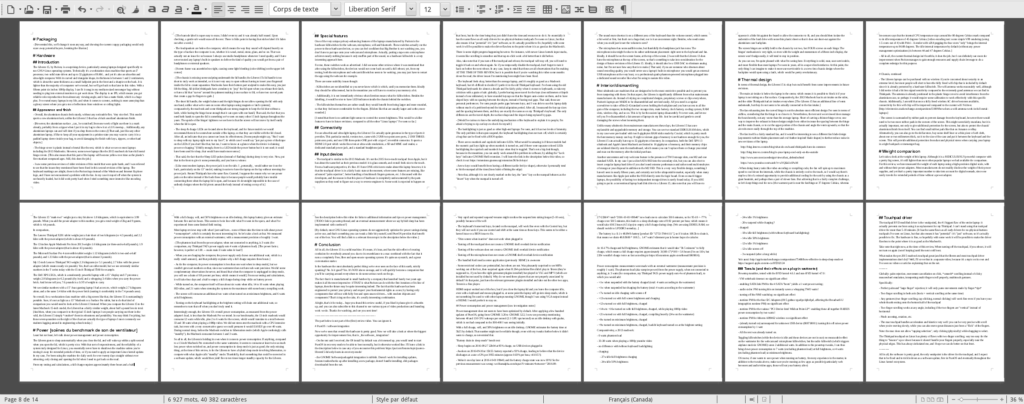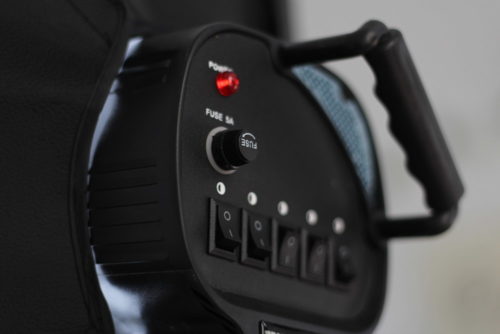Following up on my previous post where I detailed the work I’ve been doing mostly on Purism’s website, today’s post post will cover some video work. Near the beginning of October, I received a Librem 15 v2 unit for testing and reviewing purposes. I have been using it as my main laptop since then, as I don’t believe in reviewing something without using it daily for a couple weeks at least. And so on nights and week-ends, I wrote down testing results, rough impressions and recommendations, then wrote a detailed plan and script to make the first in depth video review of this laptop. Here’s the result—not your typical 2-minutes superficial tour:
With this review, I wanted to:
- Satisfy my own curiosity and then share the key findings; one of the things that annoyed me some months ago is that I couldn’t find any good “up close” review video to answer my own technical questions, and I thought “Surely I’m not the only one! Certainly a bunch of other people would like to see what the beast feels like in practice.”
- Make an audio+video production I would be proud of, artistically speaking. I’m rather meticulous in my craft as like creating quality work made to last (similarly, I have recently finished a particular decorative painting after months of obsession… I’ll let you know about that in some other blog post 😉
- Put my production equipment to good use; I had recently purchased a lot of equipment for my studio and outdoors shooting—it was just begging to be used! Some details on that further down in this post.
- Provide a ton of industrial design feedback to the Purism team for future models, based on my experience owning and using almost every laptop type out there. And so I did. Pages and pages of it, way more than can fit in a video:

A fine line
For the video, I spent a fair amount of time writing and revising my video’s plan and narration (half a dozen times at least), until I came to a satisfactory “final” version that I was able to record the narration for (using the exquisite ancient techniques of voice acting).
The tricky part is being simultaneously concise, exhaustive, fair, and entertaining. I wanted to be as balanced as possible and to cover the most crucial topics.
- At the end of the day, there are some simple fundamentals of what makes a good or bad computer. Checking my 14 pages of review notes, I knew I was being extremely demanding, and that some of those expectations of mine came down to personal preference, things that most people don’t even care about, or common issues that are not even addressed by most “big brand” OEMs’ products… so I balanced my criticism with a dose of realism, making sure to focus on what would matter to people.
- I also chose topics that would have a longer “shelf life”, considering how much work it takes to produce a high-quality video. For example, even while preparing the review over the course of 2-3 months, some aspects (such as the touchpad drivers) changed/improved and made me revise my opinion. The touchpad behaved better in Fedora 25 than in Fedora 24… until a kernel update broke it (Ugh. At that point I decided to version-lock my kernel package in Fedora).
- I was conservative in my estimates, even if that makes the device look less shiny than it is. For example, while I said “5-6 hours” of battery life in the review video, in practice I realized that I can get 10-12 hours of battery life with my personal usage pattern (writing text in Gedit, no web browser open, 50% brightness, etc.) and a few simple tweaks in PowerTop.
The final version of my script, as I recorded it, was 59 minutes long. No jokes. And that was after I had decided to ignore some topics (ex.: the whole part about the preloaded operating system; that part would be long enough to be a standalone review review).
I spent some days processing that 59 minutes recording to remove any sound impurities or mistakes, and sped up the tempo, bringing down the duration to 37 and then 31 minutes. Still, that was too long, so while I was doing the final video edit, I tightened everything further (removing as many speech gaps as possible) and cut out a few more topics at the last minute. The final rendered result is a video that is 21 minutes long. Much more reasonable, considering it’s an “in depth” review.
Real audio, lighting, and optics
My general work ethic is: when you do something, do it properly or don’t do it at all.
For this project I used studio lighting, tripods and stands, a dolly, a DSLR with two lenses, a smaller camera for some last minute shots, a high-end PCM sound recorder, a phantom-powered shotgun microphone, a recording booth, monitoring headphones, sandbags, etc.




To complement the narration and cover the length of the review, I chose seven different songs (out of many dozens) based on genre, mood and tempo. I sometimes had to cut/mix songs to avoid the annoying parts. The result, I hope, is a video that remains pleasant and entertaining to watch throughout, while also having a certain emotional or “material” quality to it. For example, the song I used for the thermal design portion makes me feel like I’m touching heatpipes and watching energy flow. Maybe that’s just me though—perhaps if there was some lounge music I would feel like a sofa 😉
Fun!
Much like when I made a video for a local symphonic orchestra, I have enjoyed the making of this review video immensely. I’m glad I got an interesting device to review (not a whole chicken in a can) with the freedom to make the “video I would have wanted to see”. On that note, if anyone has a fighter jet they’d want to see reviewed, let me know (I’m pretty good at dodging missiles 😉
Comments
3 responses to “Reviewing the Librem 15”
Except purism has been marketing their laptops as exceptionally free and open when it isn’t particularly true beyond shipping GNU/Linux: https://libreboot.org/faq/#librem
You’re referring to two challenges: the port to coreboot and the Intel “Management Engine” issue (which currently prevents being considered libreboot-ready).
Purism isn’t hiding that, it’s all right there in plain sight on multiple pages in the “Why” section of its website, which is linked as the very first item of the toplevel menu (and before that it was talked about in many blog posts on the Purism website).
Your concern is legitimate, but it raises the “How far can you go right from the start?” question:
So, considering the Intel ME is already quarantined on Librem laptops (and thus represents a rather theoretical risk at this point), that the operating stack is blob-free, that the coreboot port is ongoing… I think the approach as a whole is better than nothing (much much better than mainstream computers, actually). Hell, I’ve been running ThinkPads for years and I was not even remotely aware of the Intel ME issue, and many people are willing to have that middleground where they have modern powerful GNU/Linux-compatible hardware to “get more done” instead of limiting themselves to running only pre-2008 hardware with a specially hacked SPI flash chip, or being confined to ARM/RISC/etc.
The “let’s stay frozen in 2008 with SPI-hacked hardware” approach is not sustainable (most people don’t want to settle for decade-old hardware, and even if they wanted to, there will come a day where it will be impossible to buy it—the X200 and T400 from Lenovo have been discontinued for years already). There has to be a company pushing Free Software’s agenda all the way through the supply chain for mainstream hardware architectures, otherwise the Free Software movement will become only a distant memory.
In parallel, I think that ARM laptops are being considered as alternative solutions “until the Intel ME can be freed”, but the world of ARM is, well… a whole other world.
Also, I didn’t really want to publicly say the following, but since your comment is forcing me to: besides some inaccuracies in that Libreboot FAQ entry (AFAICS), keep in mind that the Libreboot website is owned and controlled by only one person, that FAQ does not necessarily represent the views of all Libreboot contributors (some of them have pointed that out). The person who has control over the Libreboot website also happens to own a competing company (which Purism actually links to from its website! But the reverse is not true.) So all I’m saying is: it’s not so black-and-white.
Thanks for the write up! I for one would LOVE to see another video of the stuff you cut out. You seem to have given it so much thought, I appreciate it.